Log in or create new account to save this product to your wishlist.
Detecting and combating fungus gnats
Fungus gnats are generally harmless but can damage plant roots and hover around your head. Find out how to tackle an infestation!
Latest articles
7 MIN 22 Jul How to keep your lawn in shape this summer 9 MIN 15 Jul Watering Your Garden: 10 Top Tips! 11 MIN 15 Jul Is Your Grass Type Right for your Garden? 11 MIN 10 Sep Create Your Low-Maintenance Garden – Tips and Ideas 11 MIN 08 Sep The Ultimate Guide to Choosing the Perfect Hedges for Your Garden 12 MIN 30 Aug The Top 20 Evergreen Climbers to Transform Your GardenIn the wild, fungus gnats (aka sciarid flies) pose no real problem. But get an infestation of these tiny black insects in your home, and you’ll know all about it. They feed on plant roots when they can’t find other sources of food and cause a genuine annoyance while you try and get to the heart of the problem.
- Fungus gnats at a glance
- Fungus gnat profile
- Do you have a fungus gnat infestation?
- Causes of fungus gnat infestation
- Fighting fungus gnats with natural home remedies
- How to use fungus gnat traps
- Chemical solutions against fungus gnats
- Preventative measures to protect against fungus gnats
- Fungus gnats in the garden
- FAQs
So, how do you identify fungus gnats, and how do you take action against the little critters?
Well, you’ve come to the right place: this article is about detecting and combating fungus gnats and preventing reinfestation once you’ve got rid! I’ll also recommend natural home remedies, practical traps, and chemical solutions.
Ready? Let’s get started.
Fungus gnats at a glance
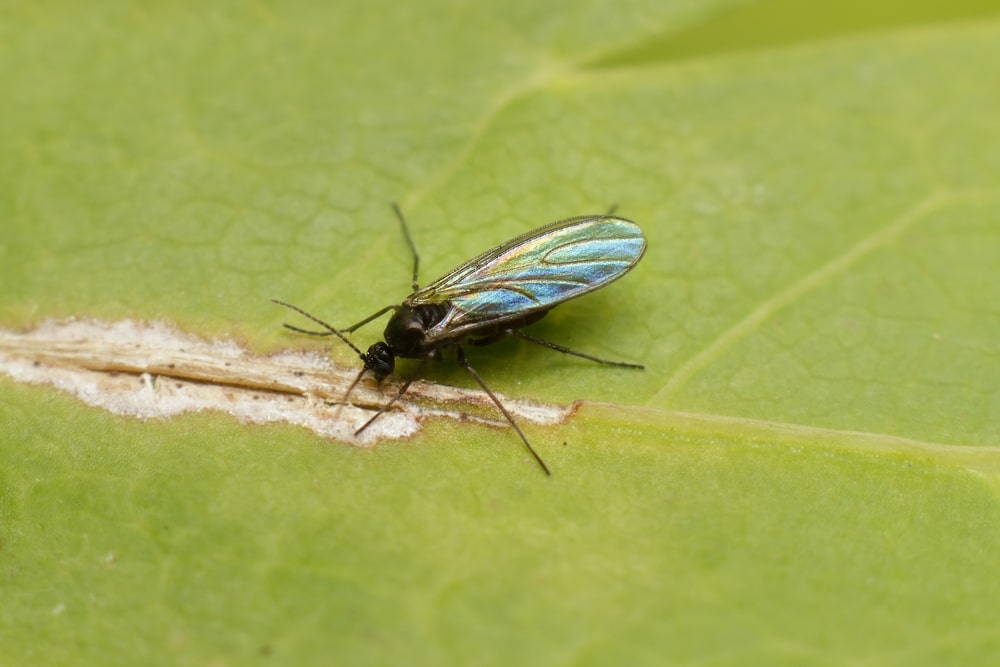
Fungus gnats are small flying insects. Outdoors, they play an essential role in the ecosystem, but indoors, they quickly become significant troublemakers. Their eggs get into flower pots filled with fresh soil, and as soon as they’ve hatched, the population will rapidly grow.
They like moist and warm conditions, so they are attracted to your breath. And before you know it, you’re batting off the fungus flies from flying in your face every couple of minutes.
Annoying!
However, while you’ll find yourself bugged out by these tiny little critters, they’re not particularly harmful. They will gnaw at your plants’ roots, which usually only negatively affects young plants.
Take action over fungus gnats
I recommend taking action as soon as you spot fungus flies in your home because each female lays around two-hundred eggs — and that adds up to an infestation in no time.
Fungus gnat profile
| Size | 1-7mm |
| Life expectancy | 1 week |
| Reproduction | 200 larvae per female |
| Habitat | Moist environments, at least 20℃ |
| Commonly found | Forests, wet meadows, moorlands |
| Food | Leaf litter, wood bark, and organic matter – absorbing only moisture |
| Feature | In some subspecies, females are wingless and unable to fly |
Do you have a fungus gnat infestation?
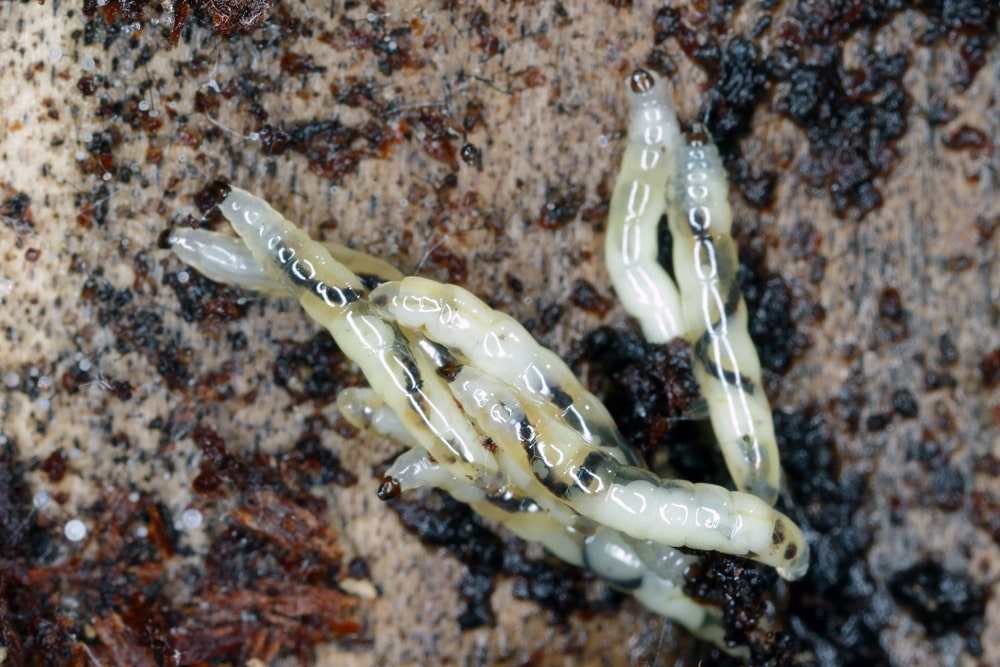
If your fungus gnat isn’t making itself known by flying in your face, you’ll recognise the problem by looking at the topsoil of your house plants.
The flies live on the soil surface or in the vicinity — you may find them on the windowsill alongside the pot if the population is overgrowing the soil.
The larvae are thin, white grubs that can grow up to 5mm long. They live in and on the soil, feeding on the roots and other organic materials such as dead leaves.
You probably won’t notice the infestation at first — but once yellow spots have appeared on your plant’s leaves, they may have already damaged the roots.
Causes of fungus gnat infestation
Fungus gnats prefer moist and nutrient-rich soil, in which they lay their eggs knowing that their larvae will have an organic food source.
Therefore:
The ideal spot for a fungus gnat infestation is in a plant pot with good-quality potting soil. It’s not necessarily a bad sign — it means that the earth is full of good-quality nutrition, which is great for your houseplants. And whether your potting compost is the cheapest in the garden centre or a selection from the premium end, larvae are likely to be found within the packaging.
The infestation is boosted by:
- Over-fertilisation
- Excessively high temperatures
- Overwatering or excessive soil moisture
The problem is exacerbated if your pots lack drainage — making the soil more likely to remain wet for longer periods.
However:
You can fight your fungus gnat infestation — you just need to know how.
Fighting fungus gnats with natural home remedies
There’s a surprising amount of effective home remedies for ridding your home of fungus gnats, including:
Spraying dish soap
Washing up liquid is a surprisingly versatile tool in the arsenal against a range of aphids and garden pests.
Mix water with a few drops of dish soap, and spray it around affected plants to kill the larvae. Very simple and effective.
However:
This is a solution for established plants and can damage seedlings and young plants.
Baking soda
Baking soda seems so innocent — great for delightful cakes and sponges — but it’s adept at cleaning out your drains and killing bugs.
So, spread baking soda over the potting soil surface with a sieve, then moisten it with a water spray.
And within a few days, the soda will penetrate the larvae and kill them. No fairy cakes for them.
Cinnamon against fungus gnats
Again, that delightful smell of Christmas is like napalm in the morning for fungus gnats. Sprinkle a thin layer of cinnamon, and the larvae will be toast in no time.
This is an excellent approach as it is safe for your plants and pets and might even make your room smell all cosy!
Killing fungus gnats with garlic

Not everyone loves garlic — but if you’re a fungus gnat, you have no chance against it.
Garlic contains the chemical Allicin, which quickly kills fungus gnat larvae. Simply slice or dice a couple of garlic cloves, and spread them across the soil.
This is a great way to kill larvae, but it depends on your relationship with the smell of garlic because your room will hum for a couple of weeks. I love it — my only concern is that it might make me hungry!
Sticking matches into the soil
Don’t worry — you’re not going to set fire to your plant! This might sound unlikely, but the sulphur in the unstruck matchhead is a great fungus-gnat deterrent.
So, stick several matches into the soil, head-end down. Then water as usual, and over time, the sulphur will leak from the match, killing the larvae.
Replace the matches every three weeks. And bear in mind; this method is only suitable for established plants.
Piling sand
Apply a thick layer of quartz sand to the potting soil, preventing the gnats from laying their eggs. Then, water your plant from below so you don’t disturb the sand layer.
Coffee grounds
Don’t throw your used coffee grounds out; use them in the garden or your plant pots. They’re full of high-quality nutrition, especially nitrogen, which will help your plants thrive.
And similar to the quartz sand approach, create a layer of dried coffee grounds across the soil surface, and the gnats won’t lay their eggs.
Ensure the grounds are dry before applying, and water from below.
Essential oils to fight fungus gnats
The following essential oils are effective in tackling fungus gnats (and will make your room smell delightful!):
- Lavender oil
- Tea tree oil
- Neem oil
Add the oil to the water, and irrigate your plants with it. You’ll need 20 drops for tea tree and lavender oil and just 10 for neem oil.
Biological warfare: Spreading nematodes
Nematodes are microscopic insects that act as parasites to other creatures in the insect population. And while that sounds a little gross, they’re considered one of the best ways to treat aphids and plant pests.
But don’t worry — you’re not replacing one insect with another, not permanently, anyway. Nematodes travel solely through moist soil. This means they won’t escape your plant pot. And once they’ve exhausted their food source (i.e., the fungus gnat infestation), they die naturally.
Find out more about these amazing critters in our expert guide to nematode use in the garden.
Bacterial attack
OK — this is starting to sound more and more like the latest instalment of the Alien movie franchise — but bear with me.
Another approach to killing fungus gnat populations is to introduce Bacillus thuringiensis israelensis (BTI) — a bacteria which will paralyse the larvae, preventing them from feeding.
Sure, it sounds a bit disgusting, but BTI, when used at the recommended rates (check the packaging), is only toxic to fly larvae, such as fungus gnats, black flies, and mosquitos.
You’re likely to need to repeat the application a few times to break the reproductive cycle for long-term control.
How to use fungus gnat traps
Fortunately, fungus gnats aren’t the Einsteins of the insect world, so they’re highly susceptible to walking into traps. Check your traps regularly, and renew them whenever necessary.
And remember: keep them out of the reach of children and pets.
Sticky fly papers
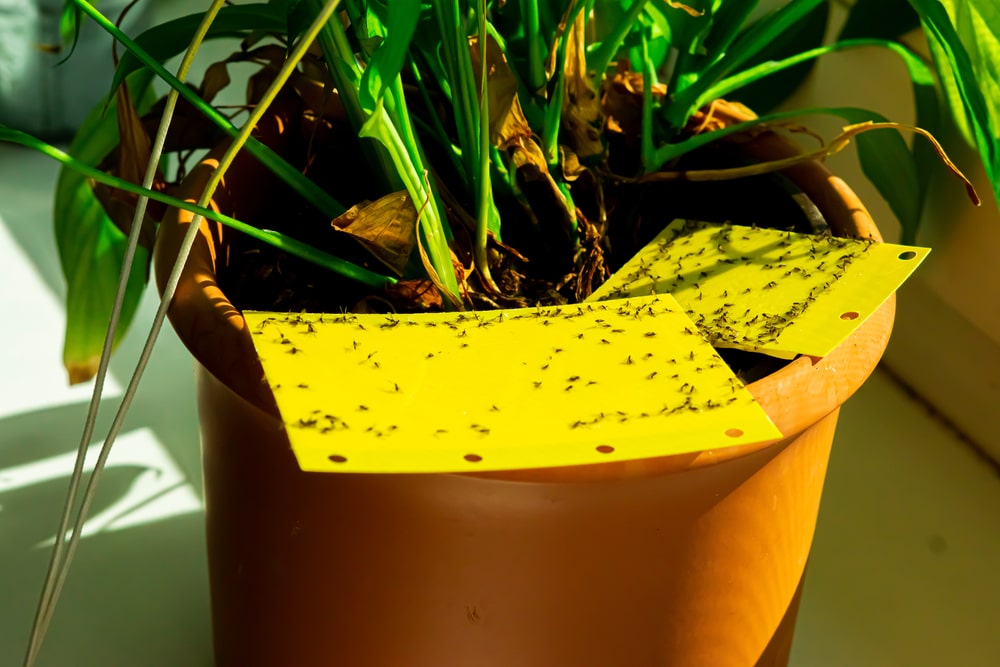
Place yellow sticky fly papers near affected plants, and the flies will be attracted to the yellow colour. And once they’ve stepped foot on the sticky stuff, they’ll get stuck (and that’s the end of them!).
Set up vinegar bowls
Place a bowl of apple cider vinegar, water, and a few drops of washing-up liquid next to the affected plant, and the gnats will swoop into the bowl (and never leave).
The washing-up liquid affects the viscosity of the water surface, which will stick the flies to the liquid.
Chemical solutions against fungus gnats
You can get chemical insecticides, which offer excellent protection against fungus gnat populations. But we always think that chemicals should be the last course of action.
If you do choose the chemical route, ensure your insecticide is suitable for indoor use. Above all, always read the instructions on the packaging.
Preventative measures to protect against fungus gnats
Now you’ve tackled the infestation, it’s time to make sure your home stays fungus-gnat-free.
The best defence against a problematic sequel is ensuring your plant pots have excellent drainage so the soil doesn’t remain soggy after watering. So, without starving your plants of essential moisture, avoid overwatering, and add a layer of sand or coffee grounds to the soil surface.
And check the soil regularly for early signs of a new infestation. The sooner you take action, the better.
Garden doctor Louis says:
You can treat potting soil by placing it in the oven before using it indoors. At 200℃, the larvae will die within 20 minutes. The microwave can be just as effective — run it for 10 minutes at maximum power. Of course, wait for it to cool down before transplanting your plants!
Fungus gnats in the garden
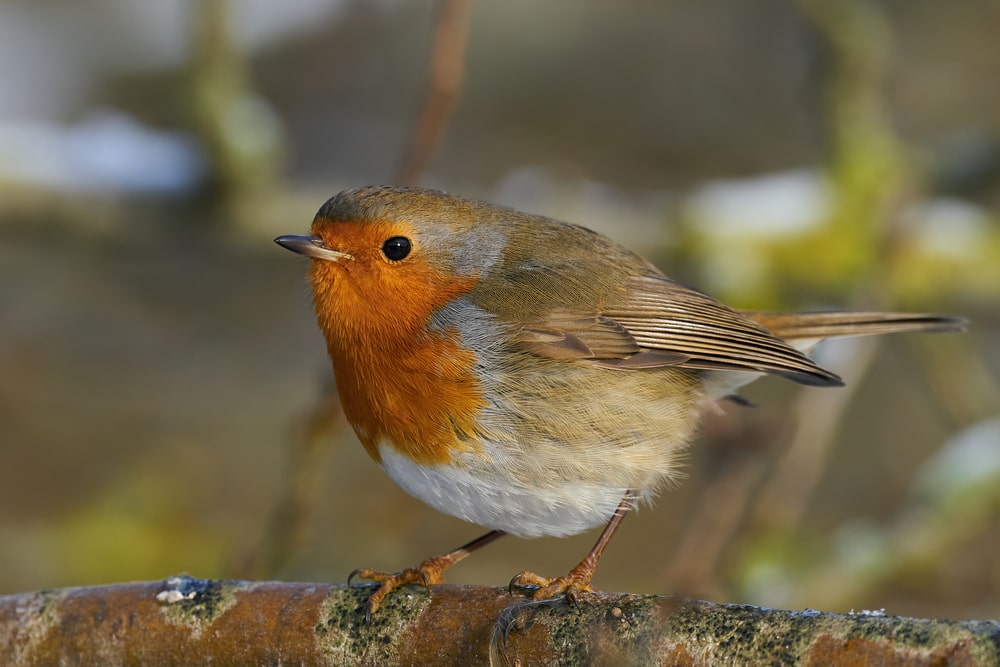
Fungus gnats rarely cause problems in your garden. This is because insects of all types are an excellent food source for birds, frogs, and spiders — so it’s uncommon to be troubled by the flies outside.
Fungus gnats are actually beneficial to your outdoor soil because they help break down organic material. This makes your earth full of beneficial microorganisms that boost the health of plant life.
If you do spot an infestation, use the remedies discussed for indoor plants. Or lay birdseed near the infestation site — and the birds will tackle the problem for you!
FAQs
Fungus gnats are small flying insects that feed on organic matter in the soil. They’re generally harmless but can be annoying as they buzz around your head, attracted to the warm moisture of your breath. However, when food sources are low, they will attack your plants’ roots.
You’ll find fungus gnats on the soil surface or around plant pots. You’ll spot their larvae — thin, white grubs which grow up to 5mm in length. Another sign of infestation is yellow or brown spots on plant leaves.
Fungus gnats live on and in moist soil. Overwatering your indoor plants can lead to an infestation, so ensure the pot has good drainage and water less often. Additionally, add a layer of sand or coffee grounds over the soil surface to prevent the flies from laying eggs.
No. They don’t bite or sting, and they don’t transmit disease. They can damage your houseplants, though, and they can be annoying as they hover around your head, attracted to your breath.
Ready to get started?
I hope you’ve got all the info you need to get tackling your fungus gnat infestation. But if you have any questions, check out our comprehensive Help & Advice section, or drop us an email.
We love hearing from you and will reply as promptly as we can.
Leave a comment
Your answer will be displayed on the site and the interested party will be notified by email.
Leave a comment
Have a question or want to share your experience? Leave us a comment.
Read more
The best tips and tricks for a lush green lawn
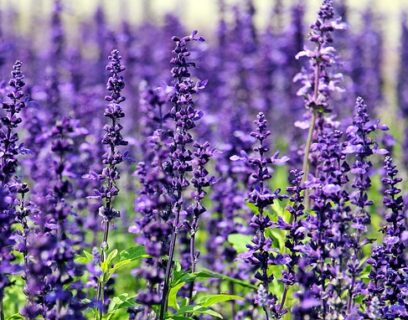 7 MIN
13 Sep
Lavender Cuttings: a step-by-step guide
7 MIN
13 Sep
Lavender Cuttings: a step-by-step guide
 11 MIN
10 Sep
Create Your Low-Maintenance Garden – Tips and Ideas
11 MIN
10 Sep
Create Your Low-Maintenance Garden – Tips and Ideas
 Scarifying Kit
All products after scarifying | Quickly restores the lawn after scarifying | Outsmart weeds quickly with the use of this kit
From: € 39.99
Scarifying Kit
All products after scarifying | Quickly restores the lawn after scarifying | Outsmart weeds quickly with the use of this kit
From: € 39.99
 Spring Lawn Care Kit
MOOWY’s choice for the spring | Quick recovery of your lawn after winter | A strong lawn prevents weeds
From: € 25.99
Spring Lawn Care Kit
MOOWY’s choice for the spring | Quick recovery of your lawn after winter | A strong lawn prevents weeds
From: € 25.99
 Long Lasting Lawn Fertiliser
Effective for 90 days | See results in 14 days! | Suitable for all types of grass and soil
From: € 13.99
Long Lasting Lawn Fertiliser
Effective for 90 days | See results in 14 days! | Suitable for all types of grass and soil
From: € 13.99
Do you want a lawn calendar?
🌱 All important maintenance moments for your lawn during the year. Leave your email and we will send you the lawn calendar for free.
Enter your email
Receive the lawn calendar in the mail
Enjoy a green lawn all year round!




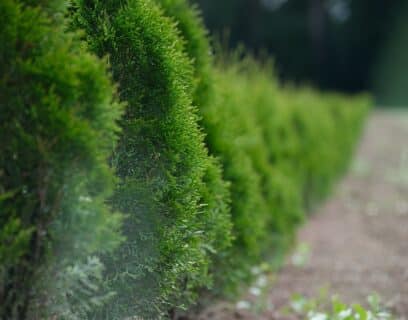






Comments (0)
There are no comments yet. Well then, what are you waiting for to
Be the first to write your comment!inaugurate this pretty page?
Do you have some comments?